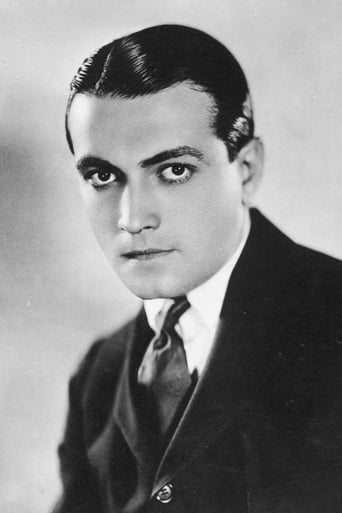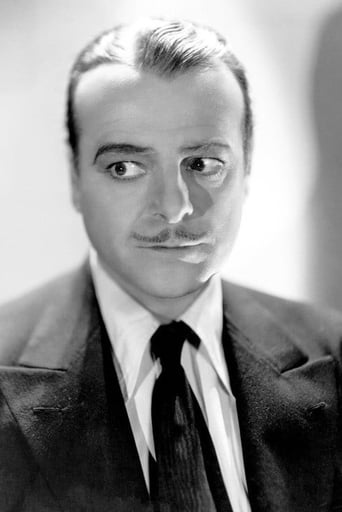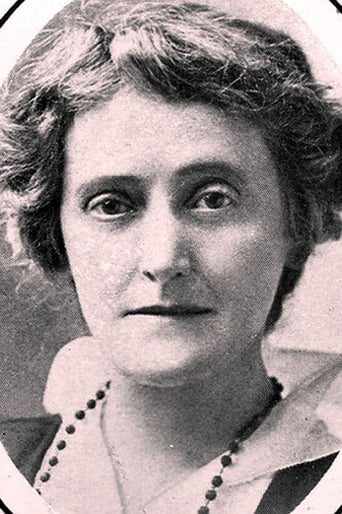ManiakJiggy
This is How Movies Should Be Made
Twilightfa
Watch something else. There are very few redeeming qualities to this film.
Asad Almond
A clunky actioner with a handful of cool moments.
kerrydragon
Terrible beginning in a story of a naive girl being hoodwinked into a sham marriage by the worst kind of pariah.Many lessons here about Money,Betrayal,Love,and Life being unfair.Musical score is too similar to a lot of Silents and Lillian Gish looks too much the same in her movies.The comical faces are too funny in this movie and I enjoyed the Party Scene where they all danced to old time tunes.For an early silent it is worth watching..
MartinHafer
The reason I say that WAY DOWN EAST is a very good film for 1920 is that even by the mid-1920s, the style film this is would probably have seemed a bit old fashioned. So, compared to late silents it's not a great movie by any stretch but it is a decent movie nonetheless and better than most films of the day. So why is it old fashioned? Well, like the characters in many of the earlier D.W. Griffith films, the peopleof in the movie often seem very one-dimensional--like a 19th century morality play. For example, Lillian Gish plays a wonderful virginal sort, there is the town tattletale, the judgmental man, the cad and the professor--all stereotypes instead of real people. But despite all this, it still is a very good film.WAY DOWN EAST begins with a poor cousin (Lillian Gish) going to the big city to spend time with her rich relatives. At this home, she is spotted by a total cad (Lowell Sherman) and he eventually asks her to marry him. However, the marriage is fake--and Gish has no idea it's not legal. After getting her pregnant, Sherman runs away--leaving her to have the baby on her own. Soon the baby dies and Gish is forced to go look for work in another town. There she gets work as a maid and becomes a beloved member of the family--that is, until word gets to the townsfolk that Gish is "that kind of woman"! This leads to an amazingly climactic scene on the ice (reminscent of the video game "Frogger") that you just have to see to believe and it's one of the best scenes Griffith ever filmed---very tense and amazing even when seen almost 90 years later.What's to like about the film? Well, the biggest star of the movie are the special effects and camera work. As mentioned above, the ice scene is simply amazing, though the snow storm is also very realistic and well done. Also, there were some very lovely camera shots--such as the scene by the lake. All these made this a first-class project.Overall, this is an important film but one that I would recommend mostly to people who already love silents. They will enjoy it considerably. However, for people not accustomed to and appreciative of the silents, it's probably one to hold off on--as you may be too quick to dismiss it because of the preachy plot and one-dimensional characters. For 1920, it was quite the accomplishment.
theskulI42
D.W. Griffith, quite possibly the man most associated with silent film as a dramatic artform, certainly the one that most comes to mind when limited to director-only (ruling out do-it-all auteurs like Chaplin and Keaton), and he is a creator of much of the universal language as well as the collective consciousness of silent film, the epic lengths, the recognizable intertitles, and of course, the glorious, copious melodrama, and there are few films that pack more melodrama into one over-the-top package than Way Down East.Way Down East follows the exploits of naive country girl Anna (Lillian Gish), who, after falling in even harder times, decides to come into contact with distant associates of wealth. One of these, cynical womanizer playboy Lennox (Lowell Sherman) attempts to court her, in an attempt to know her biblically. She, being a respectable young woman, of course refuses to indulge until she is married, so Lennox stages a sham marriage, does his business, and leaves her. Oh, but of course, he has also left her with, you guessed it, a CHILD! Once he got his way, Lennox refuses to have anything to do with her, and she is forced to raise the child on her own. She moves into a slummy apartment and is forced to claim that her husband has died, but those inquisitive patricians cannot let it lie, and discovers she was never officially married! Then, right on cue, the baby dies (or as the titles so sensationally put it, "a cold hand on her breast"). Once she is finally outed as a hussy harlot tramp have-not wench by the 'have's, she is forced to admit to her new beau that she is not only a virgin, but a hussy harlot tramp have-not wench, and is thus obliged to out her baby's daddy, and then, all hell breaks lose.Is there anyone else more perfect or practiced at this sort of histrionic theatricality than Lillian Gish? She had eyes to kill, a brittle delicacy that looks like you could shatter her with a sneeze, and the fact that everyone was always threatening to beat her up. Most of the rest of the cast are unremarkable silent veterans like Richard Barthelmess and Burr McIntosh, although Lowell Sherman plays affluent prick so well I'm convinced it was his own vocation.At 145 minutes, the film is way too long, including far too many characters and a lot of plot strands that don't really go anywhere, but this is really all part of the bloated indulgence of pure, undiluted melodrama, and although the film isn't 'great' in the objective sense, there's certainly a lot to be entertained by here.{Grade: 6/10 (C+) / #2 (of 2) of 1920}
lugonian
WAY DOWN EAST (United Artists, 1920), subtitled "a simple story about plain people," reunites director D.W. Griffith with his BROKEN BLOSSOMS (1919) co-stars, Lillian Gish and Richard Barthelmess, in an old-fashioned story based on a vintage play that turned out to become something of a commercial success and one of the true classics of the silent screen to be still remembered today. Aside from the simple-minded story consisting of country people and snobbish relatives, with a tragic heroine, a farm boy and an interloper of society whose three specialties happen to be "ladies," "ladies" and "ladies," heading the cast, it's most crucial scene, set during a violent snow storm, is the key factor of the entire photo-play, given the most realistic effect filmed on location in Vermont during the dead of winter, with Gish suffering more in real life in the freezing cold than the heroine she was portraying. And how she suffered for the art of film making as demonstrated with the close-up of Gish's frozen face in the snow storm sequence. Set in a remote village in New England, the story begins with Anna Moore (Lillian Gish), a poor girl living with her widowed mother (Mrs. David Landau) who has fallen into hard times. At her request, Mrs. Moore advises Anna to seek aid from her rich relatives in Boston. Upon her arrival at the Tremont mansion, the snobbish daughters treat Anna like an outsider, while playboy Lennox Sanderson (Lowell Sherman), one of the party guests, takes a sudden interest in her. Because of her naive ways, Anna falls into the clutches of Lennox, who tricks her into a mock marriage and bound to secrecy from his father from whom he lives on his support. When Anna discovers she is going to have a child, she insists that he tell his family. Lennox on the other hand tells her the truth about not really being married, and walks out on her. After her mother dies, Anna seeks seclusion in a rooming house where she has her baby alone. Because the child is ill, she sends for a doctor, but it is too late. The child is dead. Since there is no proof of her having a husband, Anna is turned out by an unsympathetic landlady, Mrs. Poole (Emily Fitzroy), which leads her to a farm where she is taken in and cared for by the kindly Mrs. Bartlett (Kate Bruce), even though her husband, the Squire (Burr McIntosh), "the richest farmer in the neighborhood," has his suspicions. Anna finds love and happiness with their son, David (Richard Barthelmess), but things start to fall apart upon the arrival of Lennox, along with Martha Perkins (Viva Ogden), the town gossip, learning the truth about Anna's past, thus spreading the news to the Squire, who then orders the grief-stricken Anna out of his house, into the cold.The popularity of WAY DOWN EAST prompted reissues in later years in shorter prints, with the trimming of some comedy relief and other scenes from its original 140 to 107 minutes. For decades, a 1930s reissue with Vitaphone sounding score, often similar to the underscoring of THE JAZZ SINGER (1927), was the version available for theatrical and later video cassette from various distributors, notably Blackhawk and Grapevine Video. It's interesting to point out that while this is and remains a classic of the silent screen, why television revivals were limited? The icy river sequence was clipped for the American Film Institute tribute to Lillian Gish when televised in 1983. Even by watching this scene that leaves anyone with a cold feeling would want to go see this movie. Another scene worth noting is the crucial one where Anna (Gish) performs her own baptism on her dead baby, "Trust Lennox." In 1984, WAY DOWN EAST made news in movie magazines when, after five years of hard work, was restored to its original length and revived at the Museum of Modern Art in New York City, much to the delight of silent film enthusiasts. Although the shorter version is an audience pleaser, the longer version does help make sense to the missing scenes such as whatever became of Anna's mother, for example. However, comparing the two, the restored version gives credit to the leading players and their roles in the opening while the restored version, available on both VHS and DVD format through Kino Video, does not, although its re-recording to the original soundtrack sounds almost similar to the 1930s reissue, slightly slower in tempo, but good overall.Other members of the cast include: Josephine Bernard (Mrs. Tremond); Porter Strong (Seth Holcomb); George Neville (Reuben Whipple); Edgar Nelson (Hi Holler); and Creighton Hale (Professor Sterling).Unlike BROKEN BLOSSOMS, where the characters played by Barthelmess and Gish are of equal status, WAY DOWN EAST belongs to Gish while Barthelmess has little to do, except for the key scene near the end. As famous as WAY DOWN EAST has become, the 1935 Fox Film remake starring Rochelle Hudson and Henry Fonda is something to consider in comparing to the original, but as remakes go, there's no comparison to the original, especially with the sincere performance by Lillian Gish giving one of her best screen performances of his career. Regardless of this being old-fashioned film making in the D.W. Griffith tradition, it's old-fashioned appeal and timeless theme that's actually part of the charm. Watch for it whenever it plays again on Turner Classic Movies. (***)






